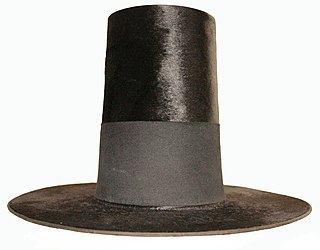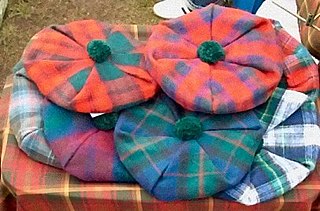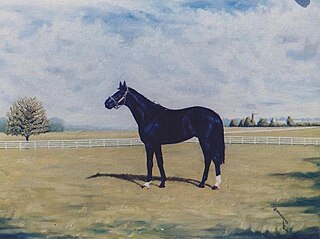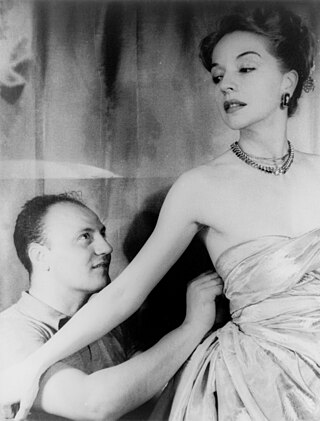
A top hat is a tall, flat-crowned hat traditionally associated with formal wear in Western dress codes, meaning white tie, morning dress, or frock coat. Traditionally made of black silk or sometimes grey, the top hat emerged in Western fashion by the end of the 18th century. Although it declined by the time of the counterculture of the 1960s, it remains a formal fashion accessory. A collapsible variant of a top hat, developed in the 19th century, is known as an opera hat.

The Welsh hat worn by women as part of Welsh national costume is a tall hat, similar to a top hat, or the capotain. It is still worn by Welsh folk-dance women, and schoolgirls, in Wales on St David's Day, but rarely on other occasions.

A flat cap is a rounded cap with a small stiff brim in front, originating in Northern England. The hat is also known in Ireland as a paddy cap; in Scotland as a bunnet; in Wales as a Dai cap; and in the United States as an English cap or Irish cap. Various other terms exist. Flat caps are usually made of tweed, plain wool, or cotton, while some are made using leather, linen, or corduroy. The inside of the cap is commonly lined for comfort and warmth.

The qeleshe, plis, qylaf or kësul is a white brimless felt skull cap traditionally worn by Albanians. It has spread throughout Albanian-inhabited territories, and is today part of the traditional costume of the Albanians. The height and shape of the cap varies region to region.

A tam o' shanter or "tammie" is a name given to the traditional Scottish bonnet worn by men. The name derives from Tam o' Shanter, the eponymous hero of the 1790 Robert Burns poem.
Lawn cloth or lawn is a fine plain weave textile, made with fine combed cotton. Terms also used include batiste and nainsook. Originally the name applied to plain weave linen, and linen lawn is also called "handkerchief linen". The term lawn is also used in the textile industry to refer to a type of starched crisp finish given to a cloth product. The finish can be applied to a variety of fine fabrics, prints or plain.

The St James's Palace Stakes is a Group 1 flat horse race in Great Britain open to three-year-old colts. It is run at Ascot over a distance of 7 furlongs and 213 yards. It is scheduled to be run each year in June.

Ascot Racecourse is a dual-purpose British racecourse, located in Ascot, Berkshire, England, about 25 miles west of London. Ascot is used for thoroughbred horse racing, and it hosts 13 of Britain's 36 annual Flat Group 1 horse races and three Grade 1 Jumps races.

Morning dress, also known as formal day dress, is the formal Western dress code for day attire, consisting chiefly of, for men, a morning coat, waistcoat, and formal trousers, and an appropriate gown for women. Men may also wear a popular variant where all parts are the same colour and material, often grey and usually called "morning suit" or "morning grey" to distinguish it; considered properly appropriate only to festive functions such as summer weddings and horse races, which consequently makes it slightly less formal. The correct hat would be a formal top hat, or if on less spacious audience settings optionally a collapsible equivalent opera hat.

A dressmaker, also known as a seamstress, is a person who makes clothing for women, such as dresses, blouses, and evening gowns. Dressmakers were historically known as mantua-makers, and are also known as a modiste or fabrician.

1880s fashion in Western and Western-influenced countries is characterized by the return of the bustle. The long, lean line of the late 1870s was replaced by a full, curvy silhouette with gradually widening shoulders. Fashionable waists were low and tiny below a full, low bust supported by a corset. The Rational Dress Society was founded in 1881 in reaction to the extremes of fashionable corsetry.

The Tyrolean hat, also Tyrolese hat, Bavarian hat or Alpine hat, is a type of headwear that originally came from the Tyrol in the Alps, in what is now part of Austria, Germany, Italy and Switzerland. It is an essential and distinctive element of the local folk costume, or tracht.

The coppola is a traditional kind of flat cap typically worn in Sicily, Campania and Calabria, where is it known as còppula or berretto, and also seen in Malta, Greece, Corsica, and Sardinia.

The pileus was a brimless felt cap worn in Ancient Greece, Etruria, Illyria, later also introduced in Ancient Rome. The pileus also appears on Apulian red-figure pottery.

Chukka boots are ankle-high leather boots with suede or leather uppers, leather or rubber soles, and open lacing, with two or three pairs of eyelets. The name chukka possibly comes from the game of polo, where a chukka is a period of play.

The Lika cap, also known as kićanka ("tassel") or crvenkapa, is an important cultural symbol of the Lika region in Croatia, part of the Lika national costume traditionally worn by local Croats and Serbs. It is cylinder-shaped, with a flat top in a red colour, black sides, and often with a black tassel in the back.
Caracalla was a French racehorse and sire. Unraced as a two-year-old and never competing at a distance shorter than 2,400 metres he was undefeated in eight races in a racing career which lasted from the spring of 1945 until October 1946. Caracalla excelled over extended distances, winning the Grand Prix de Paris and the Prix Royal Oak in France and the Ascot Gold Cup in Britain. On his final appearance he proved himself capable of beating top class opposition at middle distances when he won the Prix de l'Arc de Triomphe. He was then retired to stud, where his record was disappointing.

A half hat is a millinery design in which the hat covers part of the head. Generally, the design is close-fitting, in the manner of the cloche, and frames the head, usually stopping just above the ears. It may be similar to a halo hat in the way that it frames the face and can be worn straight or at an angle.

A mushroom hat is a millinery style in which the brim of the hat tilts downwards, resembling the shape of a mushroom. It is a style that first emerged in the 1870s and 1880s, when it was usually made of straw. It became fashionable again from around 1907 to the late 1920s; these versions featured a distinctly downturned brim although the size and shape of the crown varied according to prevailing fashions.

The tam is a millinery design for women based on the tam o' shanter military cap and the beret. Sometimes it is also known as a tam cap or the traditional term tam o'shanter might also be used. The tam became popular in the early 1920s, when it followed the prevailing trends for closer-fitting hats that suited shorter hairstyles and for borrowing from men's fashion; other traditional men's hats that rose to popularity in women's fashion during this period included the top hat and bowler. In the British Isles, the tam cap is often used as a headcovering by Christian women during church services.


















